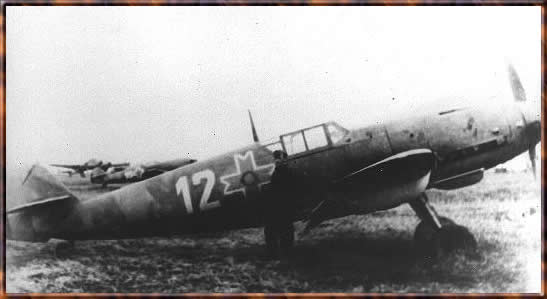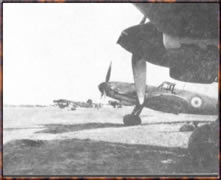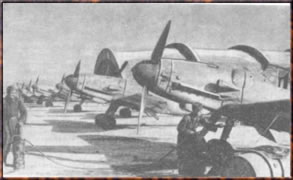
A Romanian Bf-109G2 in southern Ukraine. Summer 1943
|
|
|
The Bf-109G was also built under license at IAR works, but it's very difficult to say just how many planes were produced. In late 1943, after it had become very clear that there was no chance of improving the IAR-80 ( because the Germans refused to supply the IAR factory with the BMW 801 engines or to sell the license ), the ARR was looking for a modern fighter which could be produced in Romania. Since the 'Gustavs'
had already entered service and were highly praised by the pilots, talks of building Bf-109G's in Romania for the ARR began in late 1943.The ARR wanted to equip every fighter group with Bf-109G's manufactured
in Romania by the end of 1944. |
 |
|||
|
||||
 |
All Romanian pilots who flew the Bf-109G were delighted of the aircraft. One of Romania's aces, major Ion Dobran, said that "... If you ask me about the comparison between Messerschmitt-109 G6 and the Mustang you might not find out the truth. I might be subjective...I
for one do not compare just the usual parameters : top speed in horizontal
flight, service ceiling, maneuverability, range, weight, stall speed,
armament, visibility. |
|||
|
||||
Technical data of the Messerschmitt Bf-109G2
|
Wingspan
|
9.82 meters
|
|
Length
|
8.85 meters
|
|
Height
|
2.5 meters
|
|
Weight (empty)
|
2673 kg
|
|
Weight (loaded)
|
3148 kg
|
|
Maximum speed at 7000 meters
|
620 km/h
|
|
Climbs to 6000 meters
|
6 minutes
|
|
Service ceiling
|
11500 meters
|
|
Range
|
563 km / 1000 km ( with drop tank )
|
|
Engine
|
Daimler Benz dB 605AM rated at 1475HP
|
|
Armament
|
Two 7.92 mm MG17 machine guns plus 3 MG/FF 20 mm cannons
|
|
Payload
|
One SC 250 or 500 kg bomb
|
|
Crew
|
1
|
Technical data of the Messerschmitt Bf-109G4
|
Wingspan
|
9.82 meters
|
|
Length
|
8.85 meters
|
|
Height
|
2.5 meters
|
|
Weight (empty)
|
2673 kg
|
|
Weight (loaded)
|
3148 kg
|
|
Maximum speed at 7000 meters
|
620 km/h
|
|
Climbs to 6000 meters
|
6 minutes
|
|
Service ceiling
|
11500 meters
|
|
Range
|
563 km / 1000 km ( with drop tank )
|
|
Engine
|
Daimler Benz dB 605AM rated at 1475HP
|
|
Armament
|
Two 13 mm MG17 machine guns plus one MG/FF 20 mm cannon
|
|
Payload
|
One SC 250 kg bomb
|
|
Crew
|
1
|
Technical data of the Messerschmitt Me-109G6
|
Wingspan
|
9.82 meters
|
|
Length
|
8.85 meters
|
|
Height
|
2.5 meters
|
|
Weight (empty)
|
2673 kg
|
|
Weight (loaded)
|
3148 kg
|
|
Maximum speed at 7000 meters
|
620 km/h
|
|
Climbs to 6000 meters
|
6 minutes
|
|
Service ceiling
|
11500 meters
|
|
Range
|
563 km / 1000 km ( with drop tank )
|
|
Engine
|
Daimler Benz DB 605AM rated at 1475HP
|
|
Armament
|
Two 13 mm MG17 machine guns plus 1 MG/FF 20 mm cannon
|
|
Payload
|
One SC 250 kg bomb
|
|
Crew
|
1
|
|
Numbers produced & received
|
about 120
|